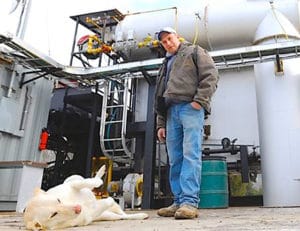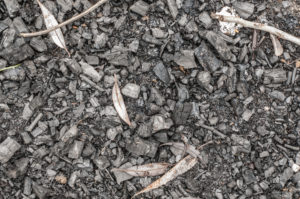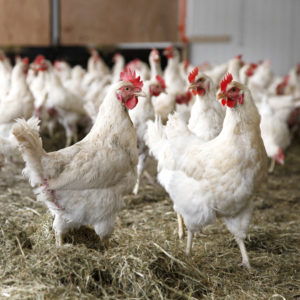By David Yarrow
From the March 2015 issue of Acres U.S.A. magazine
Biochar is a valuable soil amendment. It has gained much attention in recent years for its ability to boost soil fertility and microbiology, upgrade soil structure, and accelerate plant growth. Amid a rising tide of research and trials, what was once mostly fuel or water filtration media has suddenly sprouted dozens of innovative applications and benefits.
Researchers and farmers are have discovered many new uses for biochar, including:
- Stormwater management and treatment
- Phosphorus traps to reduce water pollution
- Nitrogen traps to reduce ammonia and nitrate pollution
- Reclamation of mine tailings
- Building material blended with cement, mortar, plaster, etc.
- Electronic microwave shielding
- Electron storage and release as a “super-capacitor”
- Carbon fiber textiles for odor-absorbent clothing
- Carbon nanofibers to replace plastic and metal
Livestock farming is offering a new and growing area of unexpected uses for biochar. Animals from earthworms to chickens, cattle, and even monkeys show shrewd interest in biochar when it is added to their food. Farmers and scientists around the globe are investigating the use of biochar in livestock production. In the European Union, biochar is carefully defined and approved for use in agriculture, with most fed to livestock or spread on farmland with manure.
This article mainly addresses poultry production, but similar issues and opportunities face other livestock producers. Research from several countries shows that adding one to three percent biochar to cattle feed improves feed efficiency by 28 percent, reduces methane by 25 percent, and increases rate of weight gain by 20 percent.

Farmer Josh Frye with his gasifier.
Biochar Added to Litter
An immediate use of biochar in poultry farming is to reduce — and even eliminate — odors from poultry litter, particularly ammonia. Biochar adsorbs gases, liquids, and ions, and ammonia (NH4+) is all three. Adsorption is the adhesion in an extremely thin layer of molecules to the surfaces of solid bodies or liquids. Activated carbon’s effectiveness for odor control is well-known and is preferred in air purifiers. Farmers can spread a blend of 5 to 10 percent biochar with conventional litter on a barn or coop floor.
Ammonia’s strong positive electric charge makes it corrosive and toxic to breathe. This gagging gas is emitted by bird droppings, creating air that is unhealthy and toxic to birds and humans. Ammonia irritates skin on contact and degrades even hard tissue, such as hooves. It also attracts insects, such as flies. This is one reason biochar can even serve as a fly deterrent. (Related Read: Non-Toxic Control of Common Insects)
Adsorption with Biocarbon
Biochar is extremely porous, making it an excellent natural filter with a huge internal capacity for water and ions. It has a more robust appetite for ammonia, ions, and other irritants and nutrients than any other organic material.
Biomass burned or baked with little or no oxygen is “reduced” to a very black, inert, dry, porous substance. In this contracted, scorched state, char is ready to vigorously attract and absorb minerals, molecules, ions, electrons, and even photons.

Black ashes or charcoal texture, background. Burnt firewood
Careful attention to biomass source, temperature, and time can produce a grade of biochar optimized for this barnyard adsorption service. Research at several universities shows activated carbon captures up to 63 percent of ammonia emitted from poultry poop. Char also curbs methane, nitrous oxide, hydrogen sulfide, urea, organic acids, ketones, volatile vapors, and noxious liquids. Biochar keeps these chemicals safely in litter, rendering them non-toxic and immobile and converting them to precious nutrients. Biochar doesn’t do all this on its own; it supports minerals and microbes that are needed to digest, break down, and convert wastes.
Depending on the type of litter, biochar can be mixed 5-10 percent by volume with litter. Effects are strong at 5 percent biochar and reach saturation beyond 15 percent. For best effect, biochar should be screened to a uniform particle size (1/4 to 1/16 inch); cleaned of dust; mixed with calcium, trace elements, clay and rock flours; lightly moistened; and inoculated with digestive bacteria and fungi. With straw pellets as litter, char is best added at the pelleting stage.
Reduced ammonia is a major health improvement for the environment, the birds themselves, and farmworkers. Lower moisture content and ammonia levels curtail risk of footpad diseases, skin lesions, and respiratory afflictions.
Because biochar also absorbs liquids, it changes the physical quality of poultry poop. Floor droppings are far less sticky — almost dry — and are lighter in weight and easier to handle, allowing litter and bedding to be managed with greater safety and sanitation.
Farmers commonly add lime and other cations to litter to help reduce odors and raise pH. Biochar’s high adsorption capacity means less lime is needed, since calcium and other cations are adsorbed into char micropores and delivered with greater efficiency. Char captures and conserves calcium and other cations, holding them where microbes and roots can access them. This further reduces ammonia emissions and improves litter’s value as a soil amendment.
Char can also be added when making silage. Char binds well with silage, providing its usual benefits of conserving moisture, buffering pH, retaining cations and anions, and providing stable refuges for fermenting microorganisms.
Biochar in Compost
When litter or bedding is spread on land, significant nutrients outgas and leach. Biochar bestows significant extra capacity to adsorp and hold nutrients in composting materials. It improves retention of ammonia and other valuable nutrients, beginning with nitrates and phosphates, with far less lost as gas and leachate. Biochar also retains water in its micropores and keeps moisture in the composting biomass.
Biochar is derived from plant biomass and creates an environment that benefits cell biology. Providing air, water, and nutrients favors healthy, beneficial microbes to improve composting rate and digestive efficiency. Biochar micropores are ideal refuges for bacteria and fungi, so adding this uniquely inert biocarbon stabilizes, strengthens, and sustains compost’s teeming populations of digestive organisms. Compost containing three to five percent biochar will likely be a higher quality premium fertilizer with more nutrients, better physical properties, and more vigorous, healthy microbial communities.
Biochar as Feed Supplement
Farmers who add biochar to litter soon notice birds peck at bits of char. They deliberately eat char — an intentional behavior. Substantial data on four continents consistently reveal that biochar as a feed additive provides direct benefits to livestock.
Dr. Casey Ritz at the University of Georgia began researching adding char to poultry bedding to control ammonia in 2007. He showed that it reduces ammonia outgassing by converting it to stable ammonium. Ritz wondered if he could do this inside a chicken.

chickens walking around in barn with hay
“We must stop ammonia before it’s made, instead of trying to mitigate it after it’s emitted,” said Ritz. “Char is a strategy with a good chance of success.”
Ritz fed chickens feed with three-percent activated carbon added, while another group received normal feed with no char. Ritz found significant drops in ammonia in manure from char-fed chickens compared to chickens given regular feed.
One Missouri farmer who feeds his chickens char observed, “When dressing chickens, I examine their gizzard and craw. I see black bits of char used to grind food. In gizzards, they’re ground smooth, almost-oval, with round ends, shiny, like river stone. So, biochar is introduced before intestinal digestion — like they chew food with charcoal teeth. Nutrient absorption starts immediately.”
He adds, with emphasis, “No ammonia smell — or any other smell, for that matter!”
The small, polished black balls form by abrasion with pebbles and food particles in the gizzard. Very fine carbon powder ground from bits of char is a catalyst to improve digestive efficiency. This benefit is both chemical and biological: it increases ion adsorption and transport while improving microbe function so the birds hardly excrete nitrogen as waste ammonia at all. Instead, nitrogen is now more fully metabolized into amino acids, which can then become proteins. Birds thus exhibit better weight gain and growth.
Chicken feed is usually light brown, but char turns it black. Happily, the color doesn’t bother chickens. Char also changes the color of their manure.
Biochar as a Digestive Catalyst
Charred carbon has no nutrient value for animals. Scientists say it is “only a filler” in feed, this understates char’s significant roles. As in soil, char provides essential services beyond being a nutrient source.
Biochar is a catalyst that brings essential elements, especially charged ions, together to encourage their reaction, but biochar itself remains largely unchanged by these reactions. Biochar provides sheltered spaces and selective surfaces for ions and microbes to assemble and interact.
Biochar is also a catalyst to facilitate populations of microbes. Many bacteria, fungi and other simple life forms take up residence in char micropores. Feeding biochar stimulates beneficial bacteria in the GI tract to strengthen digestion and immunity. It can increase nutrient adsorption, retention, and transport to improve the liver-intestine circuit.
Biochar’s probiotic benefits improve if char is pre-inoculated with digestive microbes. A fully probiotic approach must adapt to unique conditions and needs, though. A microbe culture for seed planting is different than for compost tea, or cooking compost, or foliar feeding spray, or planting trees; each must be modified to meet its specialized environment and purpose.
Biochar promotes digestion and improves feed efficiency and thus increases energy gained from feed. Toxins effectively bind to biochar, mitigating adverse effects on the digestive system and intestinal flora. The health and vitality of animals also improves, as will meat and egg production. With animals’ immune systems stabilized, infection risks from pathogens decrease.
Scientific experiments attempt to determine how much char to add to poultry feed for optimum effects, but most often char is raw and is not pre-charged with minerals or pre-inoculated with microbes. Dr. Ritz’s best guess, based on experimentation, is one or two percent of feed. His results align closely with those from Asia, Europe, Australia, and India.
Wider adoption of this old substance for this new use in farming is encumbered by three major obstacles:
• Farmers need equipment and businesses to produce and sell affordable biochar for poultry producers as a feed additive.
• The FDA, USDA, organic certification agents, states, and other regulatory bodies must review and approve char as a feed additive. Activated carbon is already approved for human use.
• We need to develop formulations of biochar with minerals, microbes, metabolites, and other nutrients, as well as protocols for use in varied farm operations and crops.
Converting Poultry Litter to Bioenergy
Some poultry farmers are beginning to produce biochar themselves. Plant biomass isn’t the only material that they can convert to char — manures can also can be dried and then burned or baked into biocarbon. Developing activated carbons and char from broiler litter is a very effective way to reduce waste volume and treat waste emissions.
Mississippi State researchers compared char made from poultry litter with commercial activated carbon made from coal for air purification. The poultry litter was mostly pine shavings plus the poop. Lab results suggest char from litter performs as well or slightly better than the commercial product.
This reduces the need to use high-value feedstocks or hard-to-harvest sources to make biochar. It rather allows farmers to convert an abundant on-farm resource — manure — into assorted valuable products, starting with bioenergy and biochar for soil.
USDA researchers recently found that charred poultry manure is extremely effective at selectively adsorbing heavy metals such as mercury, lead, and cadmium. Scientists now speculate about creating “designer biochars” tailored for specialized uses.
Combining Heat, Power and Biochar
Carbonizing manure also yields heat and can produce syngas and bio-oil for on-farm power and fuel. Gasifiers burn biomass to generate heat as well as biochar. But baking biomass by pyrolysis (coking) allows extraction of useful gas and liquid biofuels. These are well-developed technologies, but they must be adapted to make low-temperature biochars for soil.
Most poultry barns are heated in winter and early spring, and many farms burn propane to produce this heat. Burning propane produces excess moisture, though, and imported fossil fuel is expensive. A chicken producer typically spends at least $20,000 each winter on propane heat.
An alternate approach is heaters that burn biomass and yield biochar as by-product instead of oxide ash. Three immediate, abundant, cheap farm feedstocks are cornstalks, manure, and sawdust. Controlled combustion technology can capture 20 to 50 percent of biomass carbon as biochar. By restricting airflow and controlling time and temperature, farms can cut costs for off-farm fuels and fertilizers and make on-farm energy, soil amendments, litter additives, feed supplements, and water purifiers.
Biochar from Poultry Litter
In Wardensville, West Virginia, third-generation poultry farmer Josh Frye raises 800,000 chicks a year. He used to burn propane to heat his barn in winter so he could maintain production. A friend suggested a biomass gasifier that could extract energy from his own poultry manure. Frye learned that the gasifier would also yield biochar, a non-odorous soil conditioner and fertilizer.
For gasifier technology to meet his needs, Josh selected a fixed-bed gasifier built by Coaltec in Illinois and designed by Westside Energies of Canada. Coaltec helped him apply for grants to purchase and install a $1,000,000 unit. A 30-by-50-foot fixed-bed gasifier installed in March 2007 burns at low temperatures to produce biochar and heat. The maximum feed rate is 1,000 pounds per hour; this yields 5 million BTU of heat plus 3 to 4 tons of char.
Frye’s gasifier began operating in 2009, producing high-quality biochar and fossil fuel-free heat. He sold his first biochar ton at a net price of $480 a ton to a New Jersey farmer to test on corn and soybeans. A South Carolina farm is testing the char on pharmaceutical grapes. With help from International Biochar Initiative (IBI) leaders Johannes Lehmann and Stephen Joseph, Frye optimized his gasifier to make char rich in phosphorus and potassium. Test burns have produced P at 1.7-3.2 percent and K at 5.4-9.6 percent.
The first year of test burns produced 30 tons of biochar and saved 4,000 gallons of propane. Frye eventually expects to cut propane consumption by more than 80 percent. He also wants to use gasifier heat in the summer to run a chiller to cool his poultry barns.
Frye’s annual production of 125 to 600 tons of poultry litter yields 25 to 120 tons of biochar. His gasifier-produced biochar has a 10 to 34 percent carbon content. Carbon content largely depends on manure moisture content. Lower moisture yields higher carbon biochar.
“I feel I’m making a real contribution to the ag world,” said Frye. “Converting a raw waste to stable carbon-rich biochar is great.” In 2009, the West Virginia Department of Environmental Protection awarded Frye the first-ever “Clean Energy Award” for his poultry litter gasification.
Biochar from Sawdust
In Columbia, Missouri, Phil Blom of TerraChar works with Roger Reed, a combustion engineer, to install furnaces that burn sawdust into biochar to heat a boiler and heat exchanger. Reed adapted his sawdust burner to restrict air supply and make fine-texture biochar instead of ash. His high-efficiency, automated, low maintenance, small-scale gasifier uses air to move sawdust through a combustion zone and can be adjusted for other feedstocks such as corn stover, shavings, or pellets.
These burner-boiler systems are installed in barns to create hot water and deliver radiant heat. This eliminates excess moisture from burning propane. Sawdust biochar is then mixed with litter to mitigate ammonia and other odorous gases and eventually ends up in soil as nutrient-rich, composted manure.
The system they are currently building will produce 2.5 million BTUs of radiant heat per hour to heat two poultry barns. The equipment will consume 300 tons of biochar a year from 1,500 tons of sawdust biomass. In addition, the new system will send excess heat from the burner-boiler to a steam-driven 60 kilowatt-per-hour electric generator. The farmer will save up to $2,000 per month in electric expenses in addition to savings from avoided propane expenses.
David Yarrow has taught about and helped people build sustainable food systems in the Northeast United States for more than 30 years. He can be reached at dyarrow5@gmail.com. For more information, visit www.dyarrow.org.
RESOURCES:
David Yarrow, TERRA: 573-818-4148, dyarrow5@gmail.com, www.dyarrow.org/CarbonSmart
Phil Blom, Terra Char: 151 Dripping Spring Road, Columbia, MO 65202, 573-489-8929, info@terra-char.com, www.terra-char.com
Josh Frye: PO Box 218, Wardensville, WV 26851, 540-550-8856, fryepoultry@frontiernet.net, www.fryepoultry.com
Hans Peter-Schmidt: farmer and researcher, Ithaka Institute, Switzerland, www.ithaka-institut.org
Casey Ritz, Ph.D.: Poultry Science, UGA, Athens, GA 30602; 706-542- 9139, critz@uga.edu, poultry.uga.edu/personnel/ritz.htm
Kari Fitzmorris Brisolara, ScD: Environmental and Occupational Health, Louisiana State University, School of Public Health, 2020 Gravier Street, New Orleans, LA; kbriso@lsuhsc.edu
Dana Miles, Ph.D.: USDA-ARS-Mississippi State, P.O. Box 5367, Mississippi State, MS 39762; dana.miles@ars.usda.gov
Isabel M. Lima, Ph.D.: USDA-ARS-SRRC, P.O. Box 19687, New Orleans, LA 70179; isabel.lima@ars.usda.gov resources
By David Yarrow. This article was first published in the March 2015 issue of Acres U.S.A. magazine.


